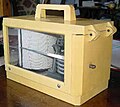barograph
A barograph ( ancient Greek βάρος báros “heaviness, weight” and γράφειν gráphein “write”) is a measuring device that records the temporal course of the air pressure on a drum covered with paper. The resulting curve is called a barogram . Such a barogram can be seen on the top right. The evaluation of the barogram can give the expert information on future weather developments. In particular, barographs are often found on ships. A sharp drop in pressure within a period of one to three hours can be an indication of an approaching strong wind or storm. A barometer is used for the actual measurement .
Barographs also play a role in aviation , especially in cross-country flying with gliders . Then, however, one often speaks of a height recorder . As the air pressure is known to decrease with altitude, the altitude profile of the flight can be analyzed after landing. For some time, however, cross-country flights have increasingly been recorded using GNSS loggers , which has led to a gradual displacement of the analog barograph from competitive aviation.
There are also barographs that register the air pressure profile on a disc, or electronic barographs where the barogram appears on an (LC) display.
A not insignificant problem with atmospheric pressure recording are mechanical vibrations for the measurement mimic. Therefore, mechanical drum barographs are often dampened. In the case of electronic barographs, the attenuation takes place either via the electronics itself or through the only discrete recording of measured values. When using barographs on ships on the seas, changes in altitude also occur due to the waves. A change in height of 8 m corresponds to an absolute pressure change of 1 hPa. This "rocking" of the measurement curve should also be removed from the actual measurement signal.
In order to record the pressure change (mechanically or electronically) one uses either aneroid cans connected in series , which add their slight path deformations due to the series connection, or piezoelectric components, which induce an electrical voltage signal due to the pressure change, which in turn can be amplified and registered. A general problem here is the temperature compensation of the measurement mimics. A temperature change at constant pressure should not change the measurement signal.
The recording of the atmospheric pressure is a necessary and often helpful indicator for the local weather forecast. The absolute value of the air pressure is almost irrelevant for the existing weather. Mainly the pressure changes are extremely helpful indicators for weather changes.






